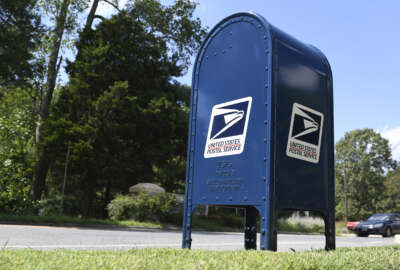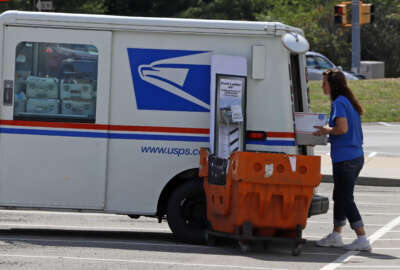‘We are tired’: USPS employees feel toll from retention challenges
The Postal Service, ramping up its workforce for its peak holiday season, still faces a critical employee shortage as well as persistent challenges retaining new...
The Postal Service, ramping up its workforce for its peak holiday season and looking to avoid a repeat of last year’s widespread mail and package delays, still faces a critical employee shortage as well as persistent challenges retaining new hires.
To compound these problems, local union employees and the USPS inspector general’s office claim USPS data doesn’t accurately capture the state of the workforce challenges, and how severely the current workforce is spread thin.
The House Oversight and Reform Committee last week reviewed the state of USPS operations at a field hearing in Chicago, one of the cities reporting worse on-time delivery metrics than the rest of the U.S. However, lawmakers see the root cause of USPS problems in Chicago as systemic to the rest of the United States.
Lawmakers at last Thursday’s hearing cited numerous complaints from constituents about slow mail delivery in their districts. But USPS is scaling up hiring and infrastructure investments ahead of the year-end holiday season to avoid what Postmaster General Louis DeJoy called “unacceptable” delays.
Acting Executive Postmaster of Chicago Eddie Morgan, Jr., who assumed his role in June, told the committee he’s ready for peak holiday operations, and said more employees are showing up for work every day after widespread absences earlier in the COVID-19 pandemic.
But Mack Julion, a city letter carrier and president of the National Association of Letter Carriers Local Branch 11, said current USPS workforce challenges have been “years in the making, and only exacerbated by COVID-19.”
“We’re not going to be able to handle the upcoming holiday season if we’re not properly staffed,” Julion said.
The USPS IG office, meanwhile, will soon release a report that will review USPS readiness nationwide for the upcoming holiday season.
USPS and other shippers already feel pressure to deliver amid persistent supply chain issues. White House Press SecretaryJen Pskai last week fielded questions about whether holiday gifts would arrive on time this year.
“We are not the Postal Service or UPS or FedEx. We cannot guarantee,” Psaki said Oct. 13.
Morgan said employee attendance has improved since the expiration of emergency federal employee leave (EFEL) on Sept. 30. However, he said USPS still faces challenges getting new hires and long-term career staff to deliver in certain parts of Chicago because of “violent crime.”
Morgan said he’s seen employee availability improve from April through August this year, and USPS is taking “appropriate progressive administrative actions” with employees who have a high number of unscheduled absences.
USPS since June hired 243 city carrier assistants and postal support employees in the Chicago area, and expects to hire an additional 180 personnel. However, Julion said local management in recent meetings said they were 500 carriers short of their goal.
Nationwide, USPS expects to hire an additional 40,000 seasonal workers before the end of the year.
Morgan said USPS faces challenges retaining new employees between the time they accept a job and the time they complete a four-day training. Part of the problem with retention, Julion said, is that new hires aren’t getting the training they need.
“We’re seeing those who are not properly trained put out on the streets before their time and because of that, they’re having a problem with the retention,” Julion said.
As recently as this August, Julion said an average of 100 to 200 full or partial routes in the Chicago areas were not getting daily delivery. Each route has up to 1,000 delivery points.
“We are tired and we are embarrassed. We are tired from working multiple assignments late into the night because, despite the OIG reports, local management has failed to properly staff the operations for which it has been entrusted,” he said.
As for retaining longer-term employees, Julion said workers feel burned out by short-staffing and pressure from management.
“It is well known within the Postal Service that there is, in some workplaces, an unhealthy level of hostility in the workplace when you’re trying to get more out of less, when you don’t have enough employees and you’re making unreasonable demands of those who are at work every day,” he said.
The USPS inspector general’s office conducted site visits last year and found mail and packages waiting up 19 days in Chicago USPS facilities without being delivered. The IG office also found service scores for Chicago were generally worse than the rest of the country.
Melinda Perez, the USPS deputy assistant inspector for audit, said these delays were driven by post offices not having enough employees to cover all delivery routes.
Perez said the extent of these delays was not accurately documented in internal postal data systems.
Julion agreed, saying postal management data provided to Congress is “consistently unreliable,” and doesn’t tell the full picture of the challenges faced by the workforce.
Accurate data, Perez said, may have allowed postal management to more proactively address these issues.
“When the mail is not accurately reported, it doesn’t allow postal management to be able to adjust fire and implement mitigating factors,” Perez said.
‘We expect and demand more’
Committee Chairwoman Carolyn Maloney (D-N.Y) said she plans to introduce a bill that would strengthen the Postal Regulatory Commission’s oversight of USPS.
The pending legislation would allow the commission to request additional information from USPS before issuing an advisory opinion on service standard changes.
The bill would also require two-thirds of the USPS Board of Governors to approve a change in service standards, if the commission determines it doesn’t have enough evidence to determine whether such changes would benefit USPS customers.
Maloney said the upcoming bill would respond to USPS recently raising rates on mail and periodicals, adding temporary holiday surcharges to packages and implementing slower delivery standards for nearly 40% of first-class mail.
“Allowing service to suffer while at the same time increasing prices will not increase the public’s faith in the Postal Service. In fact, it might end up pushing people and businesses away from using the Postal Service,” Maloney said.
Maloney said lawmakers are working to get another one of her bills, Postal Service Reform Act, to the House floor “as soon as possible.” The bill has bipartisan support, and 10 Republican senators have co-sponsored the legislation.
While lawmakers remain committed to USPS reform, Government Operations Subcommittee Chairman Gerry Connolly (D-Va.) warned the agency against making unpopular cuts.
Connolly said USPS is making “consequential and damaging operational changes at the Postal Service that affect postal delivery nationwide,” without studying the long-term impact or gauging customer satisfaction.
“We expect and demand more from our Postal Service. To do that, however, we need to provide it the resources and staffing it requires to meet customer needs,” Connolly said. “Instead, we are witnessing service standard degradation and price hikes.”
A recent USPS inspector general report found USPS only met service performance targets for three of 33 products in fiscal 2020. In the first three quarters of fiscal 2021, only USPS delivered three-to-five day mail only 61% on time.
Since April, USPS has installed 80 of 112 new package sorting machines, part of $40 billion in major capital investments the agency expects to make under its 10-year reform plan. USPS expects to have more than 50 package systems, capable of sorting large packages, online by December. USPS projects this new infrastructure will allow the agency to process an additional 4.5 million packages a day.
Copyright © 2025 Federal News Network. All rights reserved. This website is not intended for users located within the European Economic Area.
Jory Heckman is a reporter at Federal News Network covering U.S. Postal Service, IRS, big data and technology issues.
Follow @jheckmanWFED






